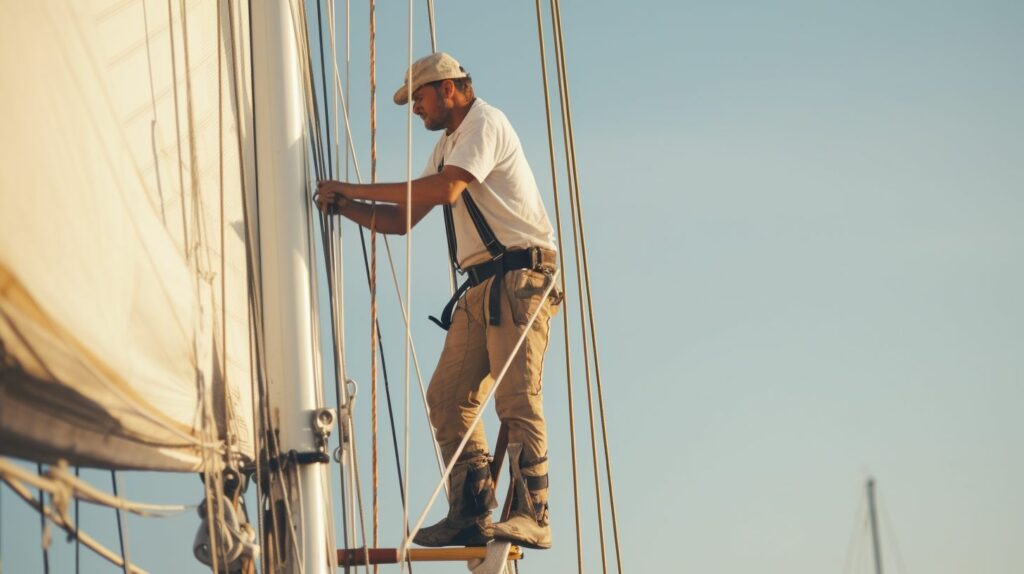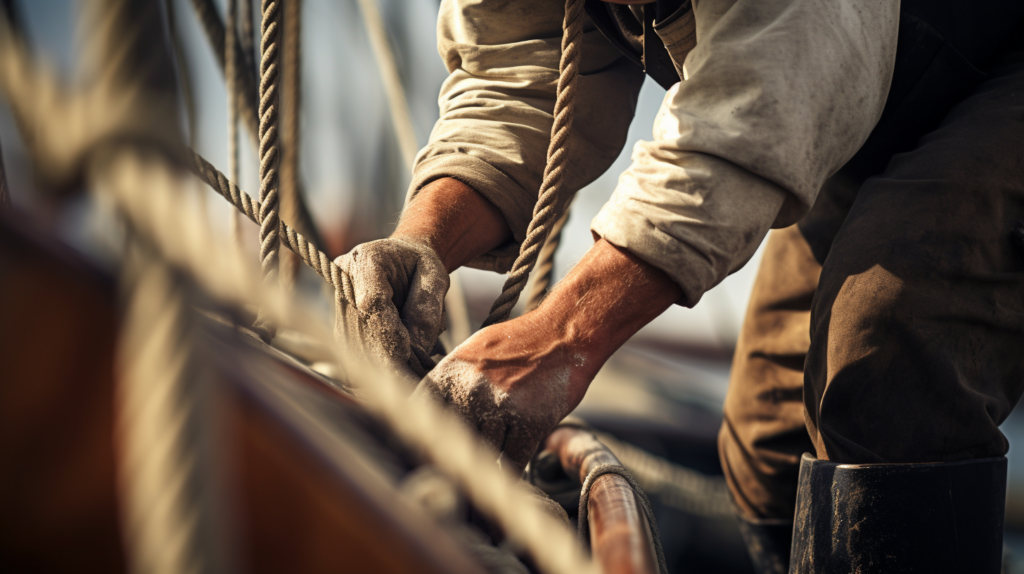Table of Contents
Table of Contents

How to take down the mast on a sailboat. Moving your sailboat to a new location can be quite an ordeal, especially for first-timers. One of the trickiest parts is removing the mast: a crucial step for trailering small vessels such as 18 ft Laguna Windrose.
This article will guide you through an effective and safe way to remove your sailboat’s mast. Read on if you’re ready to master this essential sailing skill!
Key Takeaways
- Taking down a sailboat’s mast needs careful planning and the right tools.
- It is crucial to loosen shrouds, stays, forestay, and backstay before lowering the mast.
- The process involves assistance for safety and control while bringing down the mast gradually.
- Regular checks on the sailboat’s mast help in spotting issues early.
- Safety gear is key during this process; always be aware of overhead power lines or unstable weather conditions.
Understanding the Basics of Mast Removal

Mast removal, or unstepping, is a crucial part of sailboat maintenance and relocation. As the mast is one of the tallest and most critical components of a sailboat, it’s important to carry out this procedure with care.
Fundamentally, mast removal involves detaching main parts such as the forestay and backstay while leaving sidestays attached. This technique lessens tension on the mast while keeping it secured.
Successfully removing a sailboat mast also involves working with different elements around your boat like turnbuckles, halyards, and other rigging components. It’s essential to label each piece as you disassemble them for easier reassembly when needed again.
Wiring could be tricky; making sure every bit of wiring gets disconnected before lowering can prevent damage to integral systems in your vessel. For safety reasons, using tools like lines for control along with support from cranes or saw horses can help distribute weight evenly during the lowering process.
Detailed Steps to Take Down a Sailboat Mast

Before you proceed with taking the mast down, conduct a thorough assessment to identify any potential challenges. Recognize and unfasten all necessary components like the halyard, shroud, backstay, and rigging that can obstruct or complicate the process.
Always ensure you have the right tools at your disposal which are essential for both safety and efficiency during this daunting task. Moving to the critical stage of lowering the mast requires utmost care; use a crane if available or try an alternative method such as using a gin pole if it’s a small boat situation.
All these steps demand precision and attention to detail for a successful sailboat mast removal.
Assessing the Mast
Before starting the mast removal process, it’s vital to thoroughly examine your sailboat mast. Inspect it for any signs of damage or wear that could complicate the process or compromise safety.
Check every part – from its base at the deck stepped area up to the top of the mast where halyards and rigging connect.
Regular assessment can help spot potential problems early on, such as corrosion on an aluminum mast, loose shrouds, and stays, or issues with wiring for lights at the top of a sailboat mast.
If you encounter any issues during the inspection, perform necessary repairs before proceeding with taking down your 18 ft Laguna Windrose’s mast. It’s important to ensure smooth sailing whenever navigating through Wilmington waters.
Understanding how each component functions is key – remember that removing forestay and backstay while leaving sidestays attached might not apply to all types of masts. Be prepared to adjust based on specifics related to your boat model when lowering a sailboat’s rig component.
Unfastening Necessary Components
Start with loosening the shrouds and stays that keep your mast upright. Use a wrench to loosen these vital components of your sailboat’s rigging system. Once they’re loose, move onto the forestay and backstay, unfastening them carefully while maintaining balance on the boat.
Don’t forget about the wiring connected to lights or instruments at the top of your mast. Disconnect these by pulling gently on their connectors or using a small tool for stubborn connections.
Be sure to handle all parts with care as they are crucial for reassembling your mast later.
Using the Right Tools
The success of mast removal depends largely on your tool selection. A common mistake is underestimating the weight and height of a sailboat mast, which can lead to accidents if not handled with proper equipment.
For safe and efficient removal, consider using tools like a gin pole setup or an A-frame system that provides leverage and stability while lowering the mast. If you are dealing with larger sailboats, professional hoists or cranes might be necessary due to their immense weight and size.
Always have trusted hand tools around for loosening rigging components such as turnbuckles or shackles, they come in handy during disassembly. Protecting your boat and yourself should always be a priority; therefore helmets, gloves, safety glasses, along with other protective gear should never be overshadowed by any tool used in this process.
The Actual Process of Lowering the Mast
Assuring the sailboat is secure and braced with supports, start by gradually easing the tension on the halyards. Make sure to have helpers in place, each holding a sidestay to stabilize and control the mast as it begins to descend.
Lowering the mast is a meticulous process that requires careful planning and execution. It is a task that should not be rushed and must be done with utmost caution to avoid any damage to the boat or injury to the crew.
The first step in lowering the mast is to secure all loose items on the deck, such as sails, ropes, and any other equipment that may interfere with the process. Next, the crew should release all halyards and shrouds that hold the mast in place, making sure to remove any tension on the rigging. The boom should be lowered and secured to prevent it from swinging freely during the process. Once everything is properly secured, the crew can start the actual process of lowering the mast.
This is typically done using a mechanical or hydraulic device, such as a mast-lowering system or a crane, depending on the size and weight of the mast. The crew should coordinate their actions and follow a specific sequence to maintain control over the mast as it is lowered.
It is important to ensure that the mast is lowered in a controlled and steady manner, avoiding any sudden movements or jerks that could cause damage. Once the mast is safely lowered, it should be secured and supported to prevent it from shifting or falling. Proper storage and care should be taken to protect the mast from any potential damage while it is not in use. Overall, the process of lowering the mast requires careful planning, coordination, and attention to detail to ensure a safe and successful operation.

Taking down a mast requires focus and precision. Here are some tips that can ensure a safe and well-organized mast removal process:
- Secure all loose items on your sailboat before starting the mast removal process.
- Make sure to use the right tools for unfastening the necessary components of the rig.
- Always check if the halyards, shrouds, forestay, backstay, and sidestays are released or loosened to avoid any sudden pull or tension on the mast.
- Have a clear plan on how you will control the mast during its descent: use supports like saw horses or create a cradle with poles and cushions.
- If possible, have someone assist you during this process especially when it’s your first time doing this task.
- It is critical to protect any wiring within the mast from damage while removing it; be mindful about disconnecting them in advance.
- Stay aware of potential overhead hazards such as power lines when hoisting or lowering the mast.
- Double-check whether you’ve disconnected everything such as the lights at the top of the mast before starting to lower it down.
- Remember to adequately secure your boat, especially if you’re working in windy conditions – rocking might complicate things significantly.
- As a precautionary measure, always keep everyone else away from your working area during this job.
Lessons Learned from Experienced Sailors

Experienced sailors offer a wealth of knowledge that can be beneficial for beginners. Insights from seasoned mariners reveal the importance of preparation before starting mast removal.
This includes analyzing potential risks, like overhead power lines or unstable weather conditions that could complicate the process. They advise on wearing sturdy footwear and gloves for protection and recommend having an extra pair of hands to assist with the task.
In some situations, hiring professionals can save time, and prevent mistakes or possible damage to your sailboat. Regular maintenance checks on the mast are also suggested instead of waiting until something goes wrong, as this proactivity helps in identifying any looming issues early enough for easier rectification.
Conclusion
Taking down a sailboat’s mast is a meticulous process requiring careful planning and precise execution. With attention to safety, the right tools in hand, and following clear steps, you can efficiently lower your sailboat’s mast.
While no two experiences are identical, wisdom from seasoned sailors can make your initial attempt less daunting. So strap on your sailing gear and get ready to master this skill!
Related Articles
https://www.sailorista.com/what-are-the-parts-of-a-sailboat/
FAQs – How To Take Down The Mast On A Sailboat
1. What does it mean to lower the mast on a sailboat?
Lowering the mast on a sailboat involves carefully taking down the tall, vertical pole (the mast), which supports sails and rigging.
2. Do I need a crane to lift the mast on a sailboat?
No, you don’t necessarily need a crane to lift the mast on a sailboat. While cranes can make the process easier and more efficient, there are alternative methods available. You can use mast supports, pivot systems, or even manually lift the mast with the help of a few people. These methods might require more effort and time, but they can be done without the need for a crane.
3. How do I protect the mast when lowering it onto a small boat?
To protect your aluminum mast when getting it down, consider using padding like plywood at contact points with deck or cabin top, ensuring control of the mast throughout the process.
4. Why would I need to take down the sailboat’s halyard during this process?
Taking down your sailboat’s halyard during this unstepping process assists in controlling movement as well as tension on both aft and top sections of the lowered 35-foot long or less-sized masts.
5. Have other sailors shared experiences related to “how they safely raised/lowered masts” on online forums?
Absolutely! You can learn from seasoned sailing aficionados by visiting Sailboat Owners Forums which offer insights about everything from simple ‘sail’ handling practices to controls for complex ‘masthead sloop’ spreader rigs!
6. How do I raise and lower the mast on a sailboat?
To lower and raise the mast on a sailboat, you will need to follow a specific set of steps. First, make sure the boat is secured and stable. Then, detach any rigging or lines that are connected to the mast, such as the jib halyard or mainsheet. Next, using the proper equipment and assistance, carefully lower the mast while ensuring it doesn’t swing or cause any damage. To raise the mast, reverse the process, ensuring all connections are secure and the mast is properly aligned.
7. What is the purpose of the mast step on a sailboat?
The mast step on a sailboat is the bottom part of the mast that sits in a fitting or base. Its purpose is to secure the mast and distribute the weight evenly onto the boat’s keel or support structure. The mast step ensures stability and prevents the mast from shifting or falling during sailing.
8. How do I secure the mast aft on a sailboat?
To secure the mast aft on a sailboat, you can use various methods depending on the boat’s design. One common approach is to use baby stays or additional support cables connected from the mast to the aft section of the boat. These stays prevent excessive movement or swaying of the mast, ensuring it remains secure and properly aligned.
9. Can I lower the mast onto the deck of the sailboat?
Yes, it is possible to lower the mast onto the deck of the sailboat, but it requires careful planning and execution. Using a tabernacle or similar mechanism, the mast can be hinged and gradually lowered onto the deck. It is important to ensure the mast is properly supported and secured to prevent any damage to the boat or mast itself.
10. How do I prevent the mast from swinging while taking it down?
To prevent the mast from swinging while taking it down, you can use various techniques. One approach is to use mast supports or braces that
11. Does removing a sailboat’s mainmast affect its performance out on the water?
Mast removal doesn’t directly impact sailing functionality; however, be aware that the overall voyage experience may be changed due to significant alteration in the overall weight-balance ratio experienced sans-mast.
12. How do I keep the mast secure during the procedure?
To keep the mast secure while taking it down, you can use mast supports or a tabernacle system to keep the mast from swinging.
13. Where is the mast step located?
The mast step is the location on the boat where the mast is secured. It is usually located on the deck, near the bow of the boat.
14. How do I pull the mast down?
To pull the mast down, you can use a mast winch or a mainsheet. You’ll need to release the standing rigging and gradually lower the mast onto the mast supports or deck.
15. What is the keel and how does it affect taking down the mast?
The keel is the heavy, fin-like structure at the bottom of the sailboat that helps provide stability. While taking down the mast, you need to be cautious of the keel’s position to ensure it doesn’t hinder the process.
16. How do I raise the mast back onto the boat?
Raising the mast back onto the boat requires a similar process as lowering it. Reverse the steps by using mast supports or a tabernacle system, then securely fasten the mast in place.
17. What is the role of the standing rigging in taking down the mast?
The standing rigging consists of the wires and cables that support and stabilize the mast. When taking down the mast, you’ll need to loosen and detach the standing rigging to release the mast.
18. How can I walk the mast down?
Walking the mast down involves manually carrying and guiding the mast as it is lowered. This can be done with the help of multiple crew members to ensure a safe and controlled descent.
19. Which line controls the jib during the mast takedown?
The jib halyard controls the jib sail. It needs to be properly released and secured during the mast takedown process to prevent any unnecessary movement of the jib sail.

